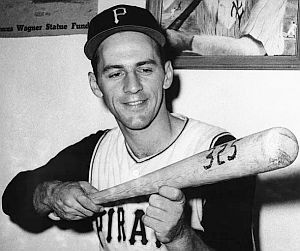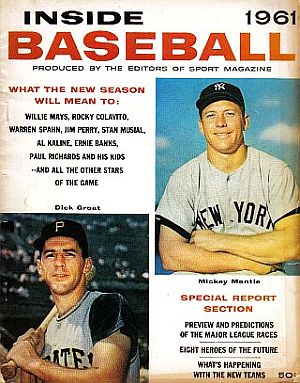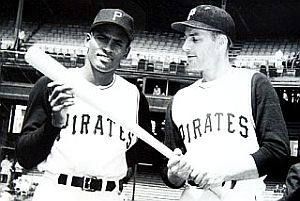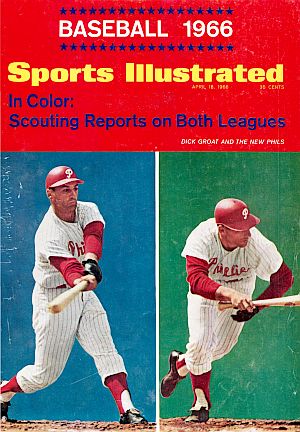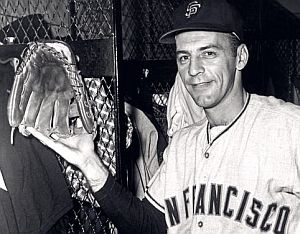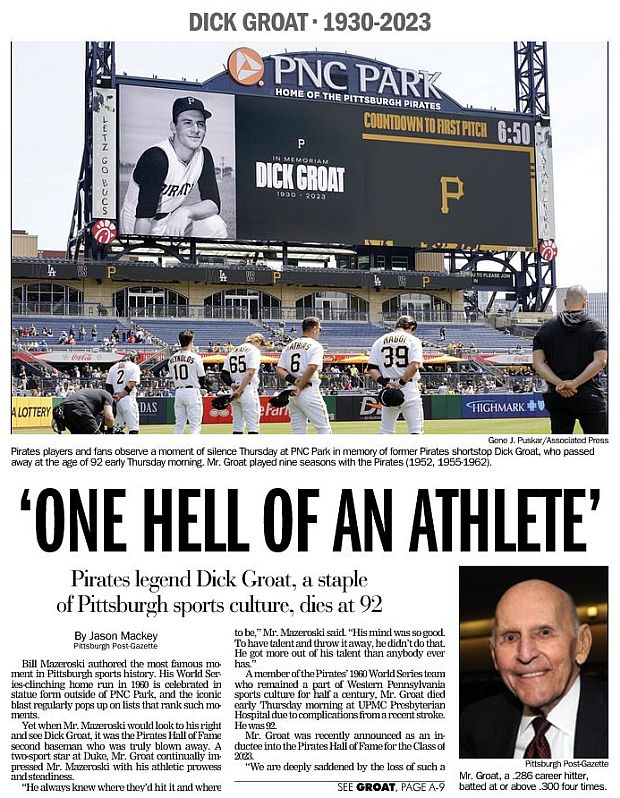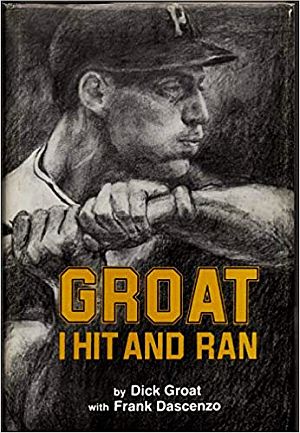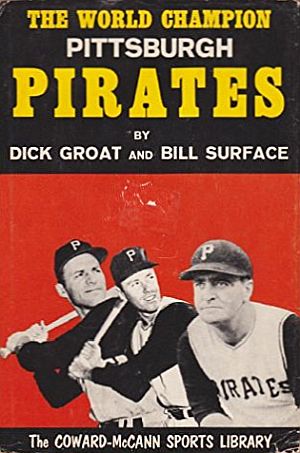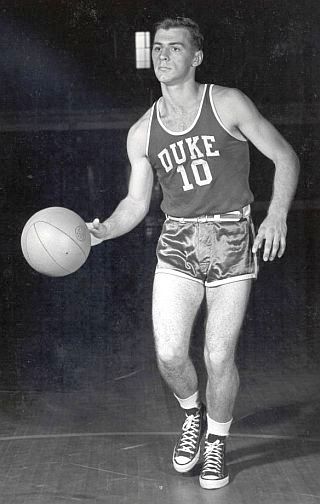
Early 1950s. Dick Groat, All-American basketball star at Duke University, became a pro baseball player with the Pittsburgh Pirates, St. Louis Cardinals & Philadelphia Phillies.
Some years later, Groat would become a key player on the famous Pittsburgh Pirates team of 1960. That team — with a roster of other key players, including Vernon Law, Bob Friend, Hal Smith, Harvey Haddix, Bill Mazeroski and others — would upset the heavily-favored New York Yankees team of Mickey Mantle, Roger Maris, Yogi Berra, Whitey Ford, et. al, in the World Series that year in an historic and memorable Game 7 drama.
In fact, Dick Groat, as a Pittsburgh Pirate, would become quite the standout that year – serving as the Pirate’s team captain, winning the National League batting title with an average of .325, and also collecting the 1960 National League’s Most Valuable Player (MVP) award.
But before his baseball heroics, there was basketball, as Dick Groat had also been an All-American basketball player at Duke University in the early 1950s, a nationally=ranked player who was selected by the then Fort Wayne (and later, Detroit) Pistons in the National Basketball Association (NBA) draft.
And for a time, Dick Groat thought he might try to play both professional sports for a few years. But in the end, baseball won out, yet basketball always tugged at his soul.
Groat was born in November 1930, the youngest of five children. As a boy growing up in the Pittsburgh area, he played more basketball that baseball, at least initially. “I played probably 20 times more basketball than I did baseball. Nobody in my neighborhood played Little League in those days…”
The first time he really started to play baseball was during his sophomore year in high school. He honed his athletic skills at Swissvale High School, where he played both baseball and basketball, and also volleyball.Groat was not a exceptionally big guy – just at 5′ 11’’, but had grit and athletic talent enough that he stood out among his peers. And when the colleges came after him, he chose Duke, receiving a basketball scholarship there, where he would also play baseball.
Groat excelled at Duke, becoming an All-American in both sports in 1951 and 1952. But it was his basketball play that distinguished Groat during his collegiate years. Roy Terrell of Sports Illustrated would later write of Groat’s basketball talents at Duke:
…As a scorer he was almost impossible to stop. He could hit from outside with a two-hand set shot or confound and confuse the opposition with his driving, stop-and-go dribble in close. He was one of the first to realize the value of the one-hand jump shot, and he used it; he was also an exceptional rebounder for his size, a tough defensive man and perhaps the best playmaker ever seen in the old Southern Conference.
In 1951 at Duke he was named the Helms Foundation Player of the Year. In 1952, he became the first and only player to lead the nation in both scoring and assists. In fact, some who watched him play were astonished at his production – one calculating that with his points and assists he was sometimes accounting for more than 55 percent of Duke’s points. In 1952 UPI named him National Player of the Year after he set an NCAA record with 839 points
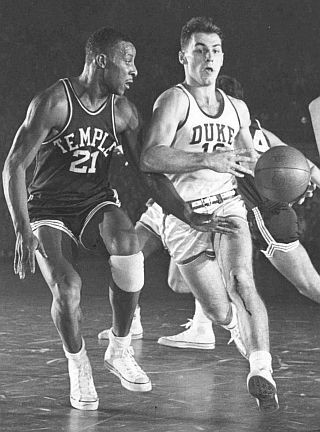
Dick Groat of Duke University driving for the bucket during his collegiate career in a game against Temple.
Groat’s 48-point performance that game, became the single-game scoring record for a Duke player. The record would stand for 36 years until December 1988 when Danny Ferry of Duke scored 58 points against Miami.
Still, in Groat’s time at Duke, the university was not keen on post-season participation of its athletic teams.
“We were 24-6 in my senior year in basketball,” Groat would recall in a later interview, “and the administration wouldn’t let us play in the NIT.”
Duke that year had upset national No. 1 West Virginia, 90-88, in the Southern Conference semifinals, but lost in the Southern Conference championship game to N.C. State, who went on to the NCAA playoffs.
In the NBA draft of April 1952, Groat was selected 3rd overall pick in round one by the Fort Wayne (later, Detroit) Pistons. He was still in college at the time, and in fact, playing his final year of college baseball that spring as well.
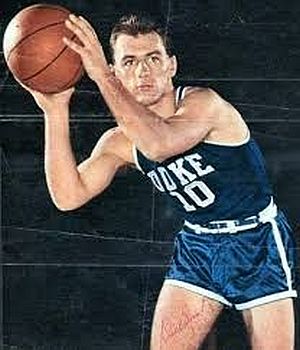
Dick Goat was drafted 3rd overall in the 1952 NBA draft and played briefly with the Ft. Wayne Pistons.
In the next season with Duke, Groat hit .370, and was again named All American. He also led the team that year in doubles, hits, runs batted in, and stolen bases.
In his collegiate career, Groat was a two-time winner of the McKelvin Award, given to the Athlete of the Year in the Southern Conference.
Pro baseball scouts, meanwhile, had noticed Groat’s play, and by 1952, three teams were interested – the Pirates, the St. Louis Cardinals and the New York Giants. The Pirates had a leg up in the competition, as Pirate scouts and general manager Branch Rickey had been following Groat’s collegiate play. In fact, Groat had been invited to a workout with the Pirates in the summer while still in his junior year at Duke. Branch Rickey wanted to sign him then, offering to put him in the Pirates’ lineup the next night if he signed a contract on the spot.
But Groat said he felt an obligation to finish what he started at Duke, planning to play basketball and baseball in his senior year. But if Rickey made him the same offer a year later, he said, he’d be glad to sign with the Pirates. Rickey agreed to bide his time. A year later, a few days after the conclusion of the College World Series, Groat signed a five-year deal with the Pittsburgh Pirates, then joining the team in New York where he played the next night at the Polo Grounds in a game against the New York Giants.

June 1952. Dick Groat, fresh from the College Baseball World Series of 1952, shakes hands with Branch Rickey, General Manager of the Pittsburgh Pirates, after signing a baseball contract to play with the Pirates, as Groat’s father looks on.
Groat played with the Pirates through the remaining games of the 1952 season, hitting .284 in 95 games that summer. But after the first season with the Pirates, he returned to Duke, where he planned on finishing his degree. However, the Ft. Wayne Pistons were still hot on his trail and wanted Groat to play basketball for them that fall.
But since Groat was finishing his degree at Duke in Durham, North Carolina, he had assumed that he wouldn’t be able to play in the NBA – “because they were in Fort Wayne and I was in Durham.” But the Pistons really wanted him. “They said they would fly me out for the games, so I flew out and played an exhibition and scored a bunch of points and they wanted to keep me around. So they just flew me into wherever they were playing.” Still, the hectic schedule of games on the road and classes at back Duke almost caused him to end his basketball career, as he later recalled:
“At one point… the weather grounded me in Detroit and I had to cut a class. In those days, if you cut three classes during one semester you were kicked out of the school. My father would have killed me if I didn’t graduate since I only needed nine credits, so I called the Pistons and told them that I quit. They told me that they had to have me back and that the owner would get me a private plane to get me back for my classes on time. Along with that, they doubled my salary, so I was making more in basketball than in baseball. With the new arrangement, I would play with my team on Monday and play at places like Madison Square Garden, and then I’d go to class Wednesday and then fly out to the next game….”
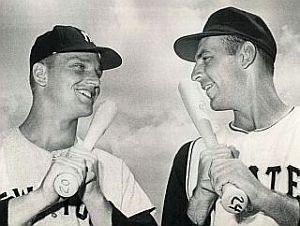 At a 1961 spring training game, Groat continued to get head- liner treatment, here with NY Yankee slugger Roger Maris. |
During his 1952-53 season with the Pistons, Groat played 26 games of the 69-game schedule. He scored 309 points on 100 (two-point) field goals and 109 free throws, with 86 rebounds, averaging 11.9 points, 3.3 rebounds, and 2.7 assists. He then had two years of military service, where he continued to excel in both basketball and baseball.
During his time at the U.S. Army base in Fort Belvoir, Virginia, near Washington, D.C., he led his teams to worldwide Army championships in both baseball and basketball – the first time a single U.S. Army base had won both titles in the same year.
In his Army play, Groat compiled a .362 batting average in baseball and a 35 points-per-game average in basketball.
In 1955, at the completion of his military service, Groat returned to Pittsburgh, ready to resume his two-sport pro careers with the Pistons and the Pirates.
“I honestly felt it would be all right to play both sports for a number of years.” But Pirate’s general manager Branch Rickey was not happy with that prospect. Rickey believed the two sports were different, and the demands on the human body would be too great – at a cost, Rickey believed, for the baseball side of the equation.
In trying to convince Rickey he could play both sports, Groat cited the example of Gene Conley, who pitched for the Milwaukee Braves pro baseball team in 1952 and also played pro basketball for the Boston Celtics.
“Don’t bring up Conley with me,” Rickey told Groat. “As a starting pitcher he only works every fourth or fifth day, and he’s only a backup center in basketball. You are a regular player in both baseball and basketball. I think you should realize that eventually you won’t justify your salary in either sport”. Rickey didn’t think an every-day player could do both.
Still, Groat said he had considered breaking his baseball contract in order to rejoin the Pistons, who had offered a higher salary and would also allow him to leave the team early for spring baseball training.
But in the end, Groat’s father weighed in as well. He was pretty insistent that his son stick with baseball, especially since in those years, professional baseball was considered the premiere, prestige professional sport – “America’s game.” More than either football or basketball at that time, baseball was the great American pastime. And legally, Groat had signed a five-year bonus contract with Rickey and the Pirates.
So, that was the end of Groat’s professional basketball career, but not the end of basketball in his life. More on that later. Still, Groat is one of 13 athletes who have played in the NBA and the Major Leagues.
The Pirates in the 1950s, meanwhile, were something of a doormat club in the National League, as Rickey was then on a building mission, soon to add high-caliber talent.
Rickey had come to the Pirates as General Manager in 1950, after he had made history with the Brooklyn Dodgers in 1947 by bringing in Jackie Robinson as the first African American player in Major League baseball.
But with Pittsburgh, Rickey had some tough seasons while he tried to rebuild. In 1952, the Pirates had one of the worst seasons in major league history, finishing with 42 wins and 112 losses, 54½ games out of first place.
Rickey had previously invented the farm system with the Cardinals, and built powerful teams with both the Cardinals and the Dodgers. Now in Pittsburgh, he set out to do the same, bringing in new blood and younger players.
Among Rickey’s successful picks were pitchers Vernon Law, Bob Friend and Elroy Face, second baseman Bill Mazeroski, outfielder Roberto Clemente, drafted from Brooklyn, and Dick Groat. These players, and a few others, would form the nucleus of the Pirates’ 1960 championship club.
Groat for his part had a few tough years at the outset, but soon found his footing. At shortstop, though not endowed with exceptional speed or the strongest arm, he was a very smart defender, typically taking the right field position for each hitter.
At the plate, by 1957, Groat was the fifth best in the National League, batting .315. In 1958 he hit .300, and led the league in putouts and double plays as the Pirates finished in second place. In 1959, he again led the league in putouts and double plays and made his first of five All-Star teams. However, in the off-season that year, he was nearly traded for Roger Maris, but the deal was cancelled by manager Danny Murtaugh.
In 1960, at age 29, Groat had a banner year with the Bucs, becoming team captain. He hit for a .325 average that year with 189 hits, winning the National League batting title. By August 1960, Groat made the cover of Sports Illustrated magazine, with the cover tagline, “Fiery Leader of the Pirates.”
Groat would also win the National League’s Most Valuable Player trophy in 1960, and help the Pirates to their World Series victory over the NY Yankees, though having just recovered from a broken wrist.
In the Series, Groat tied Game 1 at 1-1 with a first-inning double and scored to give Pittsburgh the lead, eventually winning that game 6-4, with Groat turning a double play to end the game. In Game 7, he had an RBI single and scored in the 8th inning, in which the Pirates scored 5 runs to take a 9-7 lead, eventually winning that game and the Series on Bill Mazeroski’s famed walk-off home run.
In 1961 Groat batted .275, and together with Mazeroski led the league in double plays. In 1962 he batted .294, finishing third in the league in doubles with 34, also leading the league in putouts, assists, and double plays.
But in November 1962, Dick Groat was caught by surprise, as then general manager Joe L. Brown, in need of pitching support, traded him to the St. Louis Cardinals in exchange for pitcher Don Cardwell.
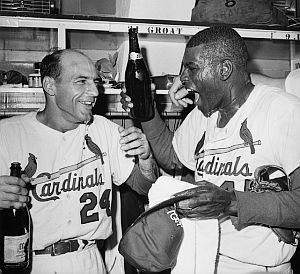 October 1964: St. Louis Cardinals shortstop Dick Groat and pitcher Bob Gibson celebrate the 1964 World Series championship. (Sports Illustrated photo). |
In St. Louis…
Dick Groat was deeply hurt by the trade to St. Louis, having set his sights on possibly coaching and managing in Pittsburgh after his playing years.
“I was heartbroken to hear that I had been traded. Pittsburgh is my hometown and I never wanted to leave. It’s the greatest city in the world and I never wanted to leave. That was one of the toughest winters that I’ve ever spent….”
In fact, for a time after the trade to St. Louis, Groat severed all contact with the Pirate organization (though later restored in 1990 after a team reunion).
In St. Louis, though, Groat became a key member of one of the best hitting infields ever assembled, including: Ken Boyer at third base, Groat at shortstop, Julian Javier at second, and Bill White at first.
By July 1963, Sports Illustrated was praising Groat’s play: “Groat, still the same deadly opposite-field hitter he was when he won the National League batting title in 1960, uses a log for a bat and merely slaps the ball wherever it is pitched.”
Groat would later say of his first year in St. Louis, “… I had the best year of my career in 1963 with the Cardinals. I hit in front of Stan Musial the whole season and I had never seen so many good pitches to hit.”
Groat finished finished fourth in the National League that year with a .319 batting average – just seven points off the top average that year – compiling 201 hits. He also led the league with 43 doubles, and was third in triples with 11. And in a year when Los Angeles Dodger pitching sensation, Sandy Koufax, was striking out everything in sight and would win the National League’s MVP award, Dick Groat was the runnerup for that award. He also earned an All-Star appearance that year.
In 1964 he batted .292 for the pennant-winning Cardinals, also leading the league in assists and double plays and making his last All-Star team.
In the 1964 World Series against the Yankees, he reached base on Bobby Richardson’s error in the sixth inning of Game 4, and scored on Ken Boyer’s grand slam in the 4-3 St. Louis victory. Groat also tagged out Mickey Mantle in the third inning of that game on a pickoff play. He scored in the 3-run tenth inning of Game 5, a 5-2 win, and had an RBI groundout in the final 7-5 win in Game 7.
To Philadelphia
After hitting .254 for the Cardinals in 1965, he was traded to the Philadelphia Phillies in a six-player deal. The Phillies that year were a good prospect for a National League pennant, according to Sports Illustrated, and Groat, a good hit-and-run man, was seen as someone who could help them get there.
The Phillies finished in the top half of the National League that year, in fourth place, at 87 and 75. Dick Groat hit .265 for the year, and his contract was sold midway through the next season, in June 1967, to the Giants (by then in San Francisco). He then split that 1967 season between the Phillies and the San Francisco Giants, ending his career that year with a .156 average in 44 games.
In his Major League baseball career, spanning 14 years and some 1,929 games, Dick Groat compiled a .286 batting average with 2,138 hits, 39 home runs, 829 runs scored, 707 runs batted in, 352 doubles, and 14 stolen bases. He made five all-star teams and won two World Series rings, one with the Pirates (1960) and St. Louis Cardinals (1964).
At the end of his playing career, Dick Groat returned to the Pittsburgh area. For many years when he played baseball, Groat had worked during the off-season as a salesman for Jessup Steel in Washington, Pennsylvania. But in 1965 he took a new direction. Groat and former Pirates teammate Jerry Lynch built a public golf course, called Champion Lakes, in the Laurel Valley, 50 miles east of Pittsburgh. And for some years thereafter, Groat would spend a good deal of time living at Champion Lakes and managing day-to-day operations there.
Back to Basketball
But then in 1979, a new opportunity came Groat’s way – one that brought him back to his first love, basketball. That’s when the University of Pittsburgh reached out to him about becoming a broadcaster for the Pitt men’s games in Division 1 NCAA play. He didn’t hesitate on the offer.
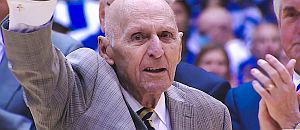
2018. Groat being honored at a Duke-Pitt basketball game.
Dick Groat was then in his version of basketball heaven! For the next 40 basketball seasons, Groat was a Pitt Panthers’ radio sportscaster, alongside partner Bill Hillgrove.
In March 2019, his tenure as a Pitt broadcaster was ended at age 88, though feeling he still had a few more seasons left. But Dick Groat was always grateful for the experience, saying at one point:

2015. Honored on Duke-Pitt program.
And over the years in Pittsburgh, and on the road, there have been special moments for Groat, some commemorating his basketball feats of the past, and others celebrating reunions with former baseball teammates, and various other special events where he has been honored.
In 2007, Groat was inducted into the National Collegiate Basketball Hall of Fame. Four years later, in 2011 he was inducted into the National College Baseball Hall of Fame in 2011. With that induction, he became the first man ever inducted into both the college basketball and college baseball halls of fame.
In March 2014, at the opening day of Pittsburgh Pirates baseball season, Groat was there at PNC Park along with Barry Bonds and Andrew McCutchen as honored guests. In mid-January 2015, when Pitt played Duke at the Cameron Indoor Stadium, a photo of Dick Groat of 1952 dribbling down court was featured on the game’s program cover. Back in Pittsburgh, meanwhile, in mid-2018, the City Council announced that “Dick Groat Day” would be celebrated on June 12, 2018. For Dick Groat, the years have been mostly kind, filled with a two-sport collection of many fans and many fine memories.
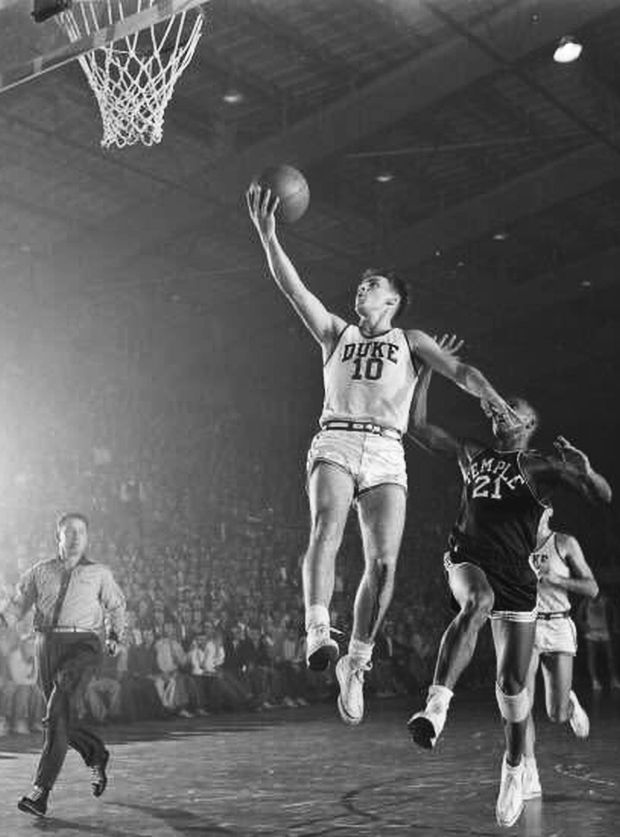
Duke University's hot young guard, Dick Groat (#10), eluding Temple defenders, and taking the ball to the bucket, early 1950s.
Readers of this story may also find “The Mazeroski Moment” of interest — a story about the famous 1960 World Series games between the Pittsburgh Pirates and New York Yankees, including background on each team’s 1960 season, key players, and review of the seven World Series games, with photos. See also the “Annals of Sport” category page for additional sports stories. And basketball fans may also find these stories of interest: “Basketball Dollars: NCAA History,” about how NCAA tournament basketball has grown in recent years to become a big money and big media enterprise; and “Bill Bradley, 1960s-2009,” about the former Princeton and New York Knicks basketball star who went on to become a U.S. Senator, presidential candidate, and author of several best-selling books.
Thanks for visiting — and if you like what you find here, please make a donation to help support the research and writing at this website. Thank you. – Jack Doyle
Story Update: At the passing of Dick Groat in late April 2023 at age 92, the Pittsburgh Post-Gazette ran a front-page story on Groat and his career with photo of then-current Pittsburgh Pirates at PNC Park in Pittsburgh paying tribute as Groat’s photo from his playing days appeared on the large stadium screen. Click photo for lnkt to that story.
|
Please Support Thank You |
____________________________________
Date Posted: 22 March 2019
Last Update: 28 April 2023
Comments to: jdoyle@pophistorydig.com
Article Citation:
Jack Doyle, “Two-Sport Man: Pittsburgh’s Dick Groat,”
PopHistoryDig.com, March 22, 2019.
____________________________________
Sources, Links & Additional Information
Walter Bingham, “Dick Groat and His Hitting Machine,” Sports Illustrated, July 22, 1963.
William Leggett, “Whose Turn in the Fratricidal National?,” Sports Illustrated, April 18, 1966.
Associated Press, “His First Sport: Ferry’s 58 Points Broke Duke Record Few Realized That Ex-Pirate Dick Groat Held,” Los Angeles Times, December 16, 1988.
Bill Brill, “Duke-UNC Memories: Dick Groat,” Blue Devil Weekly, March 5, 2004.
Steve Treder, “The Branch Rickey Pirates (Part 3: 1951-1952),” The Hardball Times, March 31, 2009.
Joseph Wancho, “Dick Groat,” Society for American Baseball Research, 2013.
Johnny Moore, “An Interview With Former Two-Sport Star Dick Groat,” GoDuke (The Magazine), June 6, 2014.
Al Yellon, “Cubs Historical Sleuthing: All-Star Edition” (There aren’t too many photos around of this game), BleedCubbieBlue.com, February 17, 2018.
Christine Coleman, “Cardinals Throwback Thursday: Basketball Stars Bob Gibson and Dick Groat,” AaronMilesFastball.com, March 20, 2014.
Chip Alexander, “He Twice Won the World Series. But Before That, He Was a Duke Basketball Star,” NewsObserver.com, January 23, 2018.
Ben Hamrick, “Baseball Legend and Pride of Swissvale,” Pittsburgh.com, June 6, 2016.
Brian Rzeppa, “An Interview With Pittsburgh Sports Legend Dick Groat,” BucsDugout.com, February 4, 2016.
James Crabtree-Hannigan, “Pittsburgh City Council Names June 12, 2018, ‘Dick Groat Day’ To Honor Pitt Broadcaster,” Pittsburgh Post-Gazette, June 12, 2018.
Ron Cook, “Ron Cook: Dick Groat is The Best Athlete To Come Out of Western Pennsylvania,” Pittsburgh Post-Gazette, June 13, 2018.
Jerry DiPaola, “In 40th and Final Year, Dick Groat Reflects on Broadcasting Pitt Basketball,” TribLive.com, March 13, 2019.
“Dick Groat,” Wikipedia.org.
“Guide to the Dick Groat Collection, 1948-1955,” David M. Rubenstein Rare Book & Manuscript Library / Duke University.
________________________________


